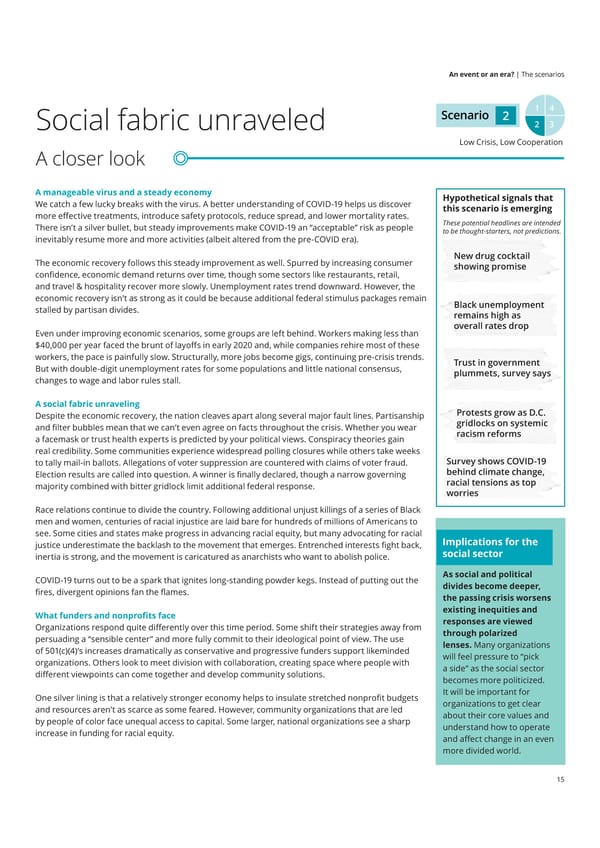An event or an era? | The scenarios Scenario 2 1 4 Social fabric unraveled 2 3 Low Crisis, Low Cooperation A closer look A manageable virus and a steady economy Hypothetical signals that We catch a few lucky breaks with the virus. A better understanding of COVID-19 helps us discover this scenario is emerging more effective treatments, introduce safety protocols, reduce spread, and lower mortality rates. These potential headlines are intended There isn’t a silver bullet, but steady improvements make COVID-19 an “acceptable” risk as people to be thought-starters, not predictions. inevitably resume more and more activities (albeit altered from the pre-COVID era). The economic recovery follows this steady improvement as well. Spurred by increasing consumer New drug cocktail confidence, economic demand returns over time, though some sectors like restaurants, retail, showing promise and travel & hospitality recover more slowly. Unemployment rates trend downward. However, the economic recovery isn’t as strong as it could be because additional federal stimulus packages remain Black unemployment stalled by partisan divides. remains high as Even under improving economic scenarios, some groups are left behind. Workers making less than overall rates drop $40,000 per year faced the brunt of layoffs in early 2020 and, while companies rehire most of these workers, the pace is painfully slow. Structurally, more jobs become gigs, continuing pre-crisis trends. Trust in government But with double-digit unemployment rates for some populations and little national consensus, plummets, survey says changes to wage and labor rules stall. A social fabric unraveling Protests grow as D.C. Despite the economic recovery, the nation cleaves apart along several major fault lines. Partisanship gridlocks on systemic and filter bubbles mean that we can’t even agree on facts throughout the crisis. Whether you wear racism reforms a facemask or trust health experts is predicted by your political views. Conspiracy theories gain real credibility. Some communities experience widespread polling closures while others take weeks to tally mail-in ballots. Allegations of voter suppression are countered with claims of voter fraud. Survey shows COVID-19 Election results are called into question. A winner is finally declared, though a narrow governing behind climate change, majority combined with bitter gridlock limit additional federal response. racial tensions as top worries Race relations continue to divide the country. Following additional unjust killings of a series of Black men and women, centuries of racial injustice are laid bare for hundreds of millions of Americans to see. Some cities and states make progress in advancing racial equity, but many advocating for racial Implications for the justice underestimate the backlash to the movement that emerges. Entrenched interests fight back, social sector inertia is strong, and the movement is caricatured as anarchists who want to abolish police. COVID-19 turns out to be a spark that ignites long-standing powder kegs. Instead of putting out the As social and political fires, divergent opinions fan the flames. divides become deeper, the passing crisis worsens What funders and nonprofits face existing inequities and Organizations respond quite differently over this time period. Some shift their strategies away from responses are viewed persuading a “sensible center” and more fully commit to their ideological point of view. The use through polarized of 501(c)(4)’s increases dramatically as conservative and progressive funders support likeminded lenses. Many organizations organizations. Others look to meet division with collaboration, creating space where people with will feel pressure to “pick different viewpoints can come together and develop community solutions. a side” as the social sector becomes more politicized. One silver lining is that a relatively stronger economy helps to insulate stretched nonprofit budgets It will be important for and resources aren’t as scarce as some feared. However, community organizations that are led organizations to get clear by people of color face unequal access to capital. Some larger, national organizations see a sharp about their core values and increase in funding for racial equity. understand how to operate and affect change in an even more divided world. 15
 US Deloitte Monitor Institute Page 14 Page 16
US Deloitte Monitor Institute Page 14 Page 16